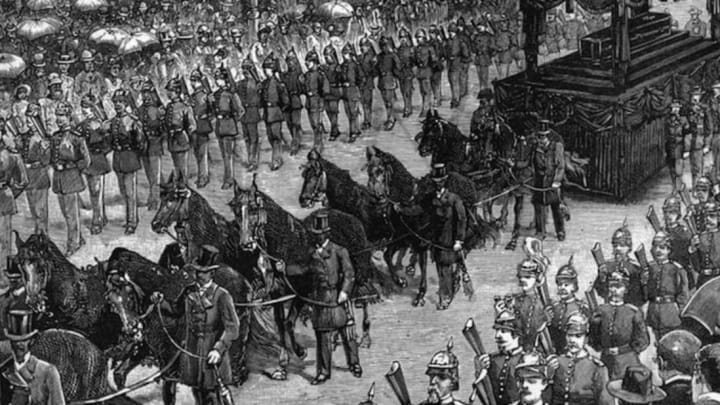Was it the automobile? Was it lead from paint? Was it poor water conditions? No — it was horse pollution.
Treating a Dead Horse
Near the end of the 19th century, cities were completely riddled with horse manure. Worse still, carcasses filled the streets. In the late 1880s, New York City was occupied by 1,206,299 people, and about 170,000 horses for transportation. Because the horses were commonly overworked and abused, the average streetcar horse had a life expectancy of about two to four years. Often, they'd die on the street, here owners would either abandon the bodies, or dump them into nearby rivers or bays.
In 1880, New York City removed 15,000 dead horses from the street. Chicago removed 9,202 horse carcasses as late as 1916. Moving the 1,300 pound carcasses was no easy task — special trucks that hung low to avoid excessive lift had to be made. Think today's traffic is bad? An 1886 article in the Atlantic Monthly described Broadway as congested with "dead horses and vehicular entanglement."
Shift Happens
It's estimated that each horse produced 15-30 pounds of manure per day. Remember, the horse population in New York City was about 170,000 in the 1880s. That means there were 3-4 million pounds of manure piling onto city streets each day.
In 1894, the Times of London estimated that every street in the city would be buried 9 feet deep in horse manure by 1950. A New York editorial estimated that horse manure would rival the height of Manhattan's 30-story buildings by 1930. Also, each horse produced about a quart of urine daily. That makes about 40,000 gallons per day in New York and Brooklyn.
Thankfully, change was on the way. The first international Urban Planning Conference was held in New York in 1898. The topic of the conference: how to deal with horse pollution. Luckily for them, the automobile was beginning to usurp the horse's role for transportation. Though experimental motor cars had been around for quite some time, the cities had previously banned them or limited their use for reasons varying from cars frightening children and horses, to cars being "rich men's deadly toys." The most well known regulation was Britain's Red Flag law, which required all cars to be preceded by a man of foot carrying a red flag.
The horse pollution crisis in the 1890s, which ignited fears of pollution and traffic jams, coupled with the rising prices of hay, oats, and urban land, led governments and urban city dwellers to embrace the automobile. By the early 1900s the horse had become unprofitable and a great environmental hazard. The car, the modern-day environmentalists' nemesis, was, at the time, a savior.
